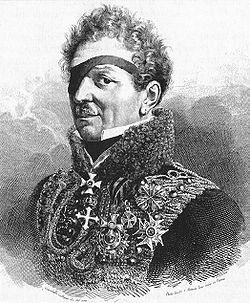 http://en.wikipedia.org/wiki/Adam_Albert_von_Neipperg
http://en.wikipedia.org/wiki/Adam_Albert_von_NeippergEarly life[edit]
Adam Neipperg was born in Vienna as a son of Count Leopold von Neipperg and his fourth wife Countess Marie Wilhelmine from the House of Hatzfeld-Wildenburg. In 1766, the County of Neipperg, centred on Schwaigern, had became an Imperial State of the Holy Roman Empire, mediatised to theKingdom of Württemberg in 1806.
At the age of fifteen, Neipperg enlisted in the French army at Strasbourg but, in 1790, he joined the ranks of the Austrians. In 1794, at Dolens, he received such serious bayonet wounds that he was left for dead on the battlefield; he lost his right eye in this battle. The following day, while burying the dead, the French found him still breathing and hospitalised him. Speaking French rather too well, he was assumed to be a traitor and sentenced to be shot once his health had returned. However, his convalescence was lengthy: by the time he recovered, the command having changed, he became part of a prisoner exchange. He also participated in the Blockade of Mayence. Neipperg then rejoined the Austrian army in Italy and took part in the Battle of Marengo in 1800.
Diplomat and General[edit]
In 1809, after the Austrian campaign, he was appointed ambassador to Sweden and encouraged Bernadotte to enter in the coalition which was formed in 1813. In reward for this service, he was decorated by the Swedish king. Neipperg rejoined the Austrian army and fought at Leipzig where he distinguished himself sufficiently to be appointed as lieutenant field marshal.
In 1814, Klemens von Metternich sent him to negotiate with the King of Naples, Joachim Murat, who signed a secret treaty with Austria in order to keep his throne. Metternich's other intrigue was to try to distance Prince Eugene (son-in-law of the King of Bavaria and stepson of Napoleon Bonaparte) from the French. By negotiating with Murat, Neipperg was again playing the role of an agent in treason after the Peace of Fontainebleau.
Marriages[edit]
Neipperg married Theresia, Gräfin von Pola (1778-1815) in 1806 and they had four sons. He was succeeded in the headship of the House of Neipperg by his eldest son Alfred (1807–1865) who was married in his second marriage to Mary, daughter of king William I of Württemberg. Having no children, his brother Erwin (1813–1897) followed him. The senior male heirs still live at Schwaigern in Germany.[1] (The present head of the house, Karl-Eugen, Count von Neipperg (* 1951) is the husband of Andrea von Habsburg.)
In August 1814, he was instructed to escort Napoleon's wife, the Empress Marie Louise, to Aix-les-Bains to take the waters. However, the true purpose of his mission was to prevent the Empress from joining Napoleon in exile in Elba. Neipperg, who had understood this perfectly, said on leaving: "In six weeks, I will be her best friend and in six months her lover". He did not need that long, Marie-Louise soon fell into his arms and talk of Elba never arose again. When Napoleon returned from exile, Murat once again allied with his Emperor triggering the Neapolitan War. Neipperg commanded a corps during the war and played a crucial role in the decisive Battle of Tolentino despite not participating in the battle.
In 1815, he participated in the short occupation of France. In July 1815, as the Austrian army crossed the Rhone, he took the command of the troops in the French departments of Gard, Ardèche and Hérault. He was under the supervision of the field marshal de Bianchi, commanding the Austrian army in the south of France. He lived in Nîmes and left the city with the rest of the troops on September 14, 1815.
Four months after the death of Napoleon in 1821, he married Marie-Louise in a morganatic marriage. She had become Duchess of Parma, Piacenza and Guastalla in the final act of the Congress of Vienna on 9 June 1815. From this union, three children were born, the first two before the marriage, whilst Marie-Louise was still legally married to Napoleon:
- Albertine, Countess of Montenuovo (Italian translation of Neipperg) (1817–1867), who married Luigi Sanvitale, Count of Fontanellato;
- William Albert, Count then 1st Prince of Montenuovo, (1819–1895), who married Countess Juliana Batthyány von Németújvár;
- Mathilde, Countess of Montenuovo, born in 1822, but dying very young.
Neipperg died in Parma. The descendants of his second family, the Princes of Montenuovo, died out in the male line in 1951.

No comments:
Post a Comment